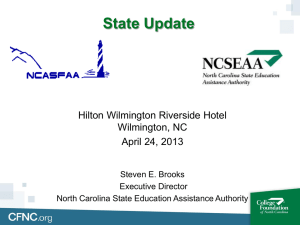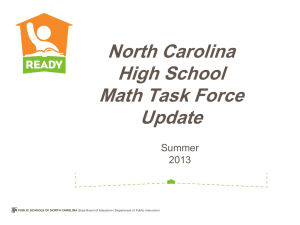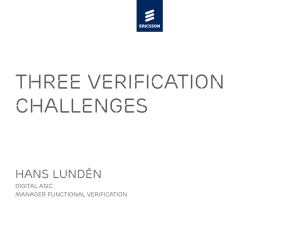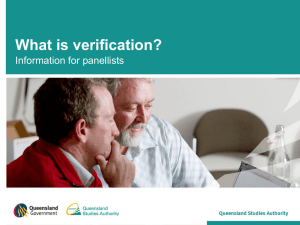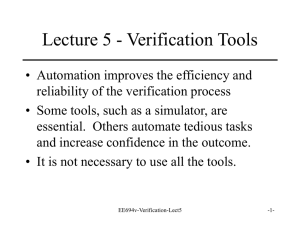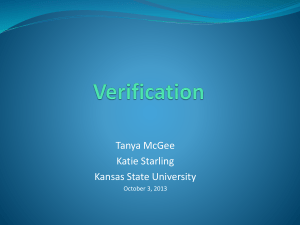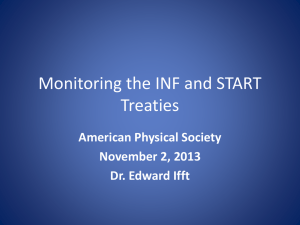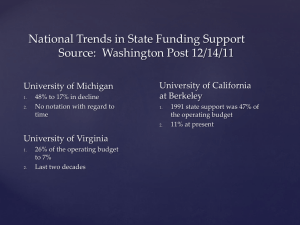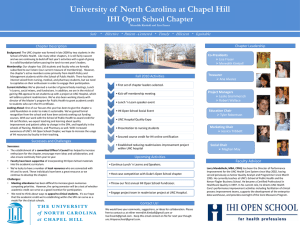Measuring and Verifying Your College`s Energy Savings
advertisement
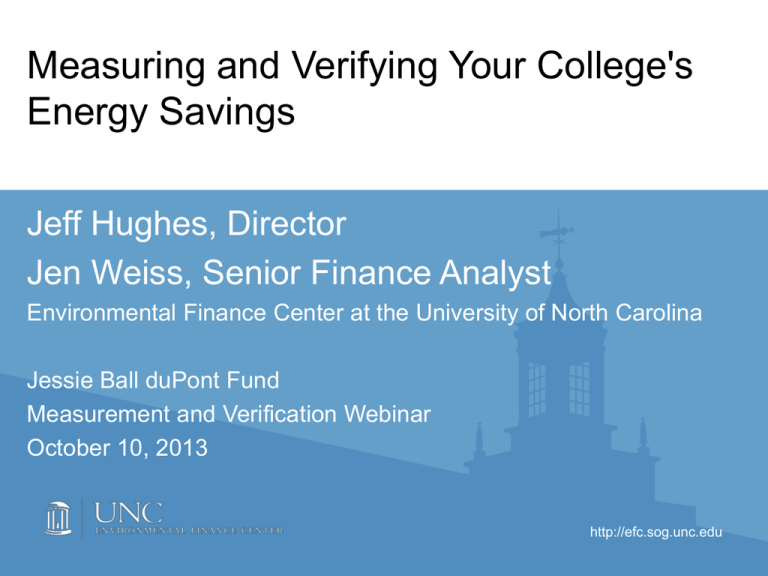
Measuring and Verifying Your College's Energy Savings Jeff Hughes, Director Jen Weiss, Senior Finance Analyst Environmental Finance Center at the University of North Carolina Jessie Ball duPont Fund Measurement and Verification Webinar October 10, 2013 http://efc.sog.unc.edu Does your school use sub-metering? 9% 3% 16% Yes, all buildings sub-metered Yes, some buildings sub-metered No buildings are sub-metered I don't know 72% “If you can’t measure it, you can’t manage it ….” Measurement and Verification: quantifying actual savings created within an individual facility Measurement vs. Verification Measurement is used to develop baseline data on energy use and helps to identify potential energy projects. Measurement monitors and assigns avoided energy costs (savings) to buildings/facilities, departments, projects and equipment. Measurement is used to evaluate the performance of project to assure project operation and implementation is adequate Verification is used to evaluate performance of project to assure that projected, and if applicable, promised, impact occurred: • • Project performance – is the project living up to its potential? Promised performance – is the project living up to its (financial) promise? Source: Federal Energy Management Program (FEMP), "Introduction to Measurement and Verification for DOE Super ESPC Projects," June 2007, http://www1.eere.energy.gov/femp/pdfs/intro_mv.pdf What does it look like? It does not have to be fancy… What does it look like? (Example from UNC-Chapel Hill M&V Program) Slide and Example Source: Daniel Arneman, UNC EFC Financing Sustainability Course 2009 What does it look like? (Example from UNC-Chapel Hill M&V Program) Slide and Example Source: Daniel Arneman, UNC EFC Financing Sustainability Course 2009 What does it look like? (Example from UNC-Chapel Hill M&V Program) Slide Source: Daniel Arneman, UNC EFC Financing Sustainability Course 2009 How do you currently track your college’s energy use? 0% We don't track energy usage 13% Third party verification 26% Energy manager / analyst (internal) 39% Computer model or Software app 65% Spreadsheets 19% Smart meters in buildings 68% Metered data (including sub-meters) 87% Utility bills 0% 10% 20% 30% 40% 50% 60% 70% 80% 90% Some Benefits of M&V Improve general operations and maintenance Monitor equipment performance Ensure proper implementation of energy projects Increase awareness of sustainable energy initiatives on campus Some Benefits of M&V (cont.) Verify that the projected avoided energy use/savings occurs Reduce cost of financing Find areas for additional energy reductions and savings Maximize energy savings by allowing for future adjustments as needed If someone asked you personally which building used the most total electricity? You would… 3% Wouldn't know where to start 28% Guess fairly accurately 34% Know where to find the answer fast 34% Answer right away with data & costs 0% 5% 10% 15% 20% 25% 30% 35% If someone asked you personally which building used the most total energy per square foot? You would 9% Wouldn't know where to start 25% Guess fairly accurately 56% Know where to find the answer fast 9% Answer right away with data & costs 0% 10% 20% 30% 40% 50% 60% Lifecycle of an energy project MEASURE VERIFY IDENTIFY ANALYZE IMPLEMENT Example – Ferrum College Example – Lynchburg College • In 2010, Lynchburg College entered into an Energy Savings Contract with Ameresco. • 22 projects were implemented: • 4,557,600 kilowatt hour reduction in electricity • 13,421,364 gallon reduction in water usage • Ameresco provides an annual report on the energy savings, however the college has also contracted with an independent third party to measure, track and verify the savings. Lynchburg College Results Lynchburg College Results Developing an M&V plan as part of project implementation • Outline project and intended results • Document baseline energy usage • Determine expected avoided energy use (savings) • Take changes in energy cost, weather and building use into consideration • Review contracts and agreements • Guarantees from energy savings performance contracts • Energy use projections from contractors • Define performance measurement • How often will measurement occur? • What types of tools will be used? • How to adjust for weather and behavioral changes Measurement and verification components and resources • Utility bills • Meters and associated metering technology • Building information (characteristics, usage, weather) • Spreadsheets • Computer models • Software applications • A qualified engaged analyst (internal or external) • Visualization dashboards • Students….. What best describes your situation? Our school has a… 17% 10% Full-time energy manager Part-time energy manager 73% No energy manager Who is responsible? • Consider the frequency of verification • In-house verification • Facilities • Sustainability Director • Energy Manager • Third party verification How much should it cost? • Consider the confidence level of the estimated energy or cost savings. • Balance the savings uncertainty against the cost to execute the plan. • 1% to 10% of typical project cost savings. • Unproven technologies may warrant additional attention. Some challenges • Historical utility data not available • Difficulty in measurement of individual projects • Comprehensive campus-wide monitoring • Sub-metered building monitoring • Project-specific • Lack of dedicated utility meters • Risk vs. benefit analysis • Other influences (weather, behavioral) Resources Lawrence Berkeley National Laboratory Measurement and Verification Portal http://mnv.lbl.gov/ M&V Guidelines: Measurement and Verification for Federal Energy Projects http://www1.eere.energy.gov/femp/pdfs/mv_g uidelines.pdf Energy Star’s Portfolio Manager http://www.energystar.gov/index.cfm?c=evalu ate_performance.bus_portfoliomanager Green Revolving Investment Tracking System (GRITS) http://greenbillion.org/grits Last thought: shiny toys should be tied to objectives… Thank you! http://efc.sog.unc.edu 27 Jeff Hughes jhughes@sog.unc.edu 919-843-4956 Jennifer Weiss jweiss@sog.unc.edu 504-606-8148 Environmental Finance Center at the University of North Carolina School of Government, Knapp-Sanders Building CB #3330 Chapel Hill, NC 27599-3330 USA http://efc.sog.unc.edu
